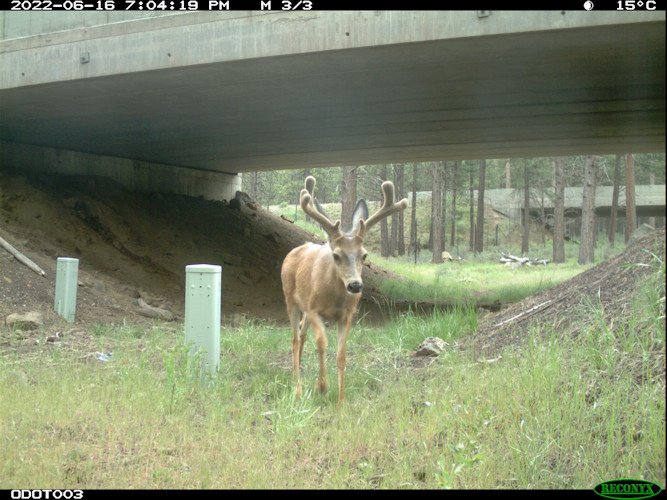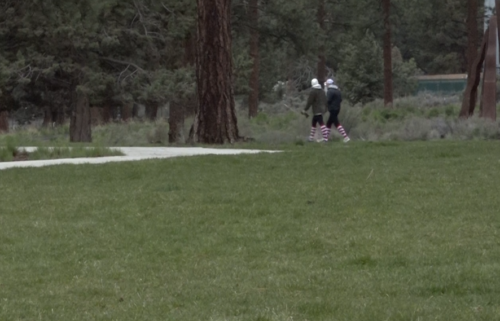Drivers beware: Vehicle-wildlife collisions peak this time of year — but Hwy. 97 crossings cut risk dramatically

Roadkill salvagers reminded to get animal tested for Chronic Wasting Disease
SALEM, Ore. (KTVZ) — Vehicle collisions with deer and elk tend to peak in October and November, when migration and breeding (the "rut") puts them on the move, making them more likely to cross roads. Fewer daylight hours and rainy weather also reduce drivers' visibility, ODFW said Wednesday.
On average, ODOT documents more than 6,000 vehicle collisions with deer and elk each year. The actual number of collisions is likely higher, as many are not reported if there is minimal damage or no human injuries.
ODFW and ODOT are asking Oregonians to Watch out for Wildlife this time of year and follow these tips:
- Be careful when driving in areas that have special signs indicating the possible presence of wildlife. These signs are posted for a reason.
- Be alert in areas with dense vegetation along the road or while going around curves. Wildlife near the road may not be visible.
- If you see one animal, stay alert. There may be others nearby.
- If you see wildlife on or near the road, slow down and stay in your lane. Many serious crashes are the result of drivers losing control as they swerve to avoid wildlife.
- The same advice applies for smaller wildlife like raccoons; try to stay in your lane and do not swerve for these animals. They are less dangerous to vehicles than big game animals and maintaining control of your vehicle is most important.
- Always wear your seat belt. Even a minor collision could result in serious injuries.
ODFW, ODOT and partner organizations are working to reduce the risk of vehicle-wildlife collisions by building wildlife crossings. The crossings allow wildlife to safely follow their migration patterns over or under a road. Data shows wildlife crossings on Highway 97 near Sunriver have reduced vehicle-wildlife collisions by nearly 90 percent.
The bipartisan infrastructure bill passed by Congress in 2021 is providing $350 million in competitive grants to the states for wildlife crossings and other mitigation. ODFW, ODOT and other partners will be working to secure grants for projects.
Oregon drivers can also show their support by purchasing a Watch for Wildlife license plate. The revenue generated from license plate sales will benefit projects that help wildlife move within their range and between habitat patches. Originally developed by the Oregon Wildlife Foundation, the license plate is now available at the DMV.
Roadkill salvagers: CWD testing is mandatory
As wildlife-vehicle collisions peak, so does participation in ODFW's roadkill salvage program. Since 2019, salvaging deer or elk struck by a vehicle has been legal in Oregon. Salvagers are required to fill out a free online permit available at https://myodfw.com/articles/roadkill-salvage-permits
Since the program kicked off in January 2019, 5,027 permits have been issued, with most for black-tailed deer in Western Oregon, where there are more drivers.
Salvagers are also required to bring the head and antlers of all salvaged deer and elk to an ODFW office for testing within five days. This is so ODFW can test the animal for Chronic Wasting Disease (CWD), a fatal neurological disease that ODFW has been on the lookout for since it first appeared in the late 1960s in Colorado.
The disease has never been detected in Oregon's wildlife. But CWD testing regulations have taken on new urgency after it was detected in several wild deer and elk in northwest Idaho, about 30 miles from Oregon's border, late last year.
Infected animals can spread the disease for several years before showing symptoms (which include loss of balance, drooling, emaciation or wasting and eventual death). Testing apparently healthy deer and elk early in the course of the disease when they are not showing symptoms is the most effective method to catch the disease before an animal has spread the disease across the landscape and to other animals.
"With the disease now much closer to the state's borders, we just want to remind roadkill salvagers about the mandatory testing requirements." explained ODFW Wildlife Veterinarian Dr. Colin Gillin. "The more animals the state tests, the more certain ODFW can be that the disease is not in the state. If it is detected, ODFW can implement its response plan to contain the spread of the disease.
Test results are expected to take up to a month. If an animal ever tests positive for CWD, a biologist or veterinarian will phone the person who salvaged that animal directly.
 |
| Figure 1. Total roadkill salvage permits issued by month. Red boxes indicate peak animal movement (migration and rut) seasons. Oregon 2019 – 2022. |
Negative test results will be posted for roadkill salvagers to individually check online at https://www.dfw.state.or.us/wildlife/health_program/CWD-testing/ To find your result, enter RSP before your permit number (e.g. RSP5001).




